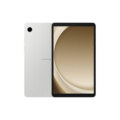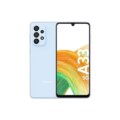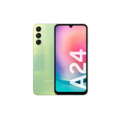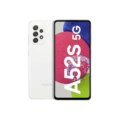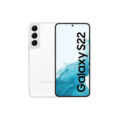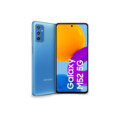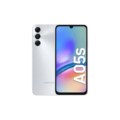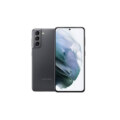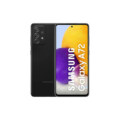Samsung Galaxy A03
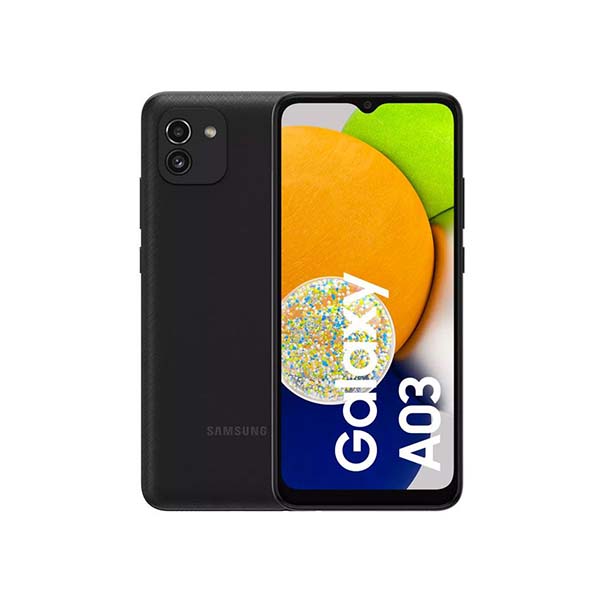

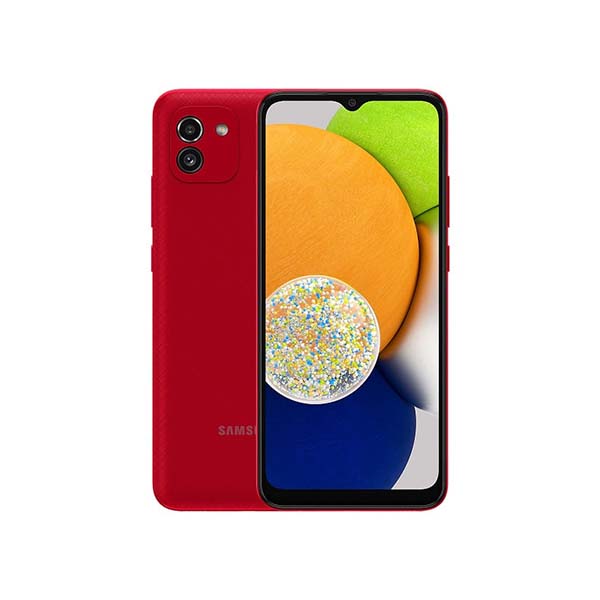
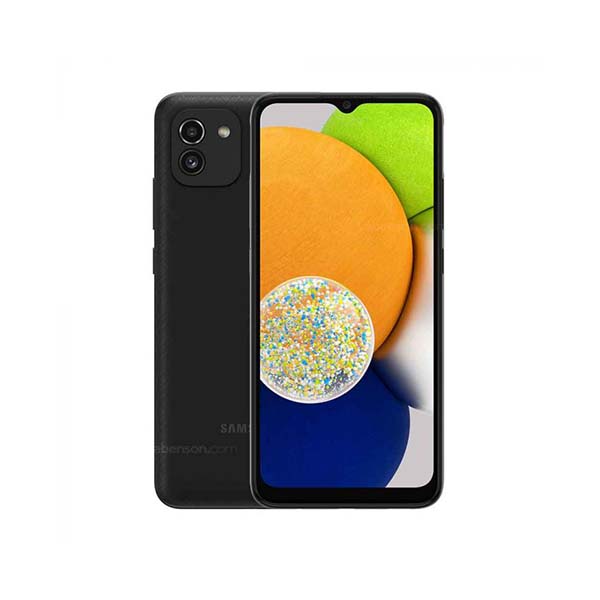
Specs
General
| Device Type | Smart Phone |
| Model | SM-A035F, SM-A035F/DS, SM-A035M, SM-A035G |
| Announced | 26 November, 2021 |
| Released | 21 January, 2022 |
| Status | Available |
Design
| Dimensions | 164.2 x 75.9 x 9.1 mm |
| Weight | 196 g |
| Protection | Glass front + Plastic back |
| Colors | Black, Blue, Red |
Display
| Refresh Rate | 60 Hz |
| Display Type Display Technology => A number of display technologies and types used in mobile phones => TFT (Thin Film Transistor), IPS (In-Place Switching), OLED (Organic Light Emitting Diode), AMOLED (Active-Matrix Organic Light-Emitting Diode), Super AMOLED (an even advanced version of AMOLED), Resistive Touchscreen (Resistive touchscreens contain two layer of conductive material with a very small gap between them which acts as a resistance), Capacitive Touchsceen (Capacitive touchscreen technology consists of a layer of glass coated with a transparent conductor) | PLS TFT LCD |
| Size | 6.5 inches (16.51 cm) |
| Resolution | 720x1600 px (HD+) |
| Display Colors Display Colors is refers to the number of different shades of colors that the screen is capable of displaying => 64K colors, 256K colors and 16 million colors, Obviously 16M is highest available range of colors and better than others. | 16M colors |
| Pixel Density Pixel Density (PPI) is refers to the concentration of pixels on a particular display, measured in pixels per inch (ppi). Pixel density is calculated by dividing the diagonal pixel resolution of a display by its diagonal size, higher pixel density better display quality. | 270 ppi |
| Touch Screen | Yes, Capacitive Touchscreen, Multi-touch |
| Display Protection Display Protection => Gorilla Glass is a special alkali-aluminosilicate glass shield with exceptional damage resistance that helps protect mobile displays from scratches, drops, and bumps of everyday use, It is always better to go for a smartphone with Gorilla Glass for that added protection and peace of mind. | gorilla glass |
Camera
| Front Camera | 5 MP f/2.2 |
| Camera Setup | Double |
| Main Camera Camera is able to capture photographs and usually videos, The most important characteristics of a camera are the resolution (measured in megapixels), lens focus type (fixed or automatic), higher megapixel cameras are known to capture higher quality photos, but not always a good measurement of the photos quality. |
48 MP, f/1.8, (wide), AF 2 MP, f/2.4, (depth) |
| Image | 8000 x 6000 Pixels |
| Video | 1920x1080 @ 30 fps |
| Camera Features | Geo-tagging, touch focus, face detection, panorama, HDR, Video (1080p@30fps) |
| Flash Flash Light => There is commonly two types of flash lights are used in camera mobile phones, LED Flash (LED flash offers lower power consumption with drive circuitry that takes up very little room, LEDs can be strobed faster than any other light source), Xenon Flash (xenon flash produces an extremely intense full-spectrum white light for a very short duration) | LED flash |
Hardware
| Operating System OS => Every computer system run on a base software called Operating System (OS). Operating System controls all basic operations of the computer (such as smartphone, PDAs, tablet computers and other handheld devices). The Operating System allows the user to install and run third party applications (apps), apps are used to add new functionality to the device. | Android 11.0 |
| Chipset Chipset is a group of integrated circuits designed to perform one or a more dedicated functions, often with real time computing constraints, Popular smartphones are equipped with more advanced embedded chipsets that can do many different tasks depending on their programming. | Unisoc T606 |
| CPU CPU (Central Processing Unit) mostly known as processors, CPU processes instructions in order to carry out certain functions that make your device operate properly. Processors are often described as the brain of computers, smartphones and tablets, Smartphones and tablets rely on processors to carry out their every task, Processors are an incredibly important factor in selecting any type of computing device, including your smartphone. | Octa core (1.6 GHz, Dual core, Cortex A75 + 1.6 GHz, Hexa Core, Cortex A55) |
| Architecture | 64 bit |
| Fabrication | 12 nm |
| GPU GPU (Graphics Processing Unit) is a single-chip processor designed to rapidly manipulate and alter memory to accelerate the creation of images in a frame buffer intended for output to a display, This includes things such as lighting effects, object transformations, and 3D motion. | Mali-G57 MP1 |
| RAM (Memory) RAM (Random Access Memory) is a type of computer memory that can be accessed randomly, any byte of memory can be accessed without touching the preceding bytes that allows information to be stored and accessed quickly from random locations. RAM is the most common type of memory found in computer systems, smartphones, tablets and other electronic devices. | 3 GB |
| Internal Storage Internal Storage is a data storage space (flash memory) mostly used in smartphones, tablets and other electronic devices where operating system, apps, music, photos, videos, files and other user data Is stored. | 32 GB |
| Card Slot Memory Card Slot is a special slot for inserting a memory card. Memory cards allow you to expand the phone's built-in memory, A memory card (sometimes called a flash memory card or a storage card) is a small storage medium used to store data such as text, pictures, audio, and video, for use on small, portable or remote computing devices such as mobile phones, mp3 players, digital cameras. | |
| Sensors Sensors are electronic components that detects and responds to some type of input from the physical environment. The specific input could be light, heat, motion, moisture, pressure and location, The output is generally a signal that is converted to use in computing systems, a location sensor, such as a GPS receiver is able to detect current location of your electronic device. | Accelerometer, Proximity |
Network
| SIM TYPE SIM (Subscriber Identity Module) is a small card that contains mobile network subscriber's account information. This allows the phone using the card to attach to a mobile network. The SIM card is most commonly associated with GSM and UMTS mobile networks. Moving a SIM card from one phone to another allows a subscriber to switch mobile phones without having to contact their mobile network carrier. SIM cards can also be used by a phone to store limited amounts of data, such as phone numbers and text messages. | Nano SIM |
| SIM Technology | Dual Sim, Dual Standby |
| 2G Network | GSM 850 / 900 / 1800 / 1900 |
| 3G Network | HSDPA 850 / 900 / 1900 / 2100 |
| 4G Network | LTE band 1(2100), 3(1800), 5(850), 7(2600), 8(900), 20(800), 38(2600), 40(2300), 41(2500) |
Multimedia
| FM Radio | |
| Stereo Speakers | YES |
| Loudspeaker | YES |
| Audio Jack | 3.5mm Audio Jack |
| Audio Features | Dolby Atmos |
Connectivity
| Wi-fi Wi-Fi is a popular wireless networking technology using radio waves to provide high-speed network connections that allows devices to communicate without cords or cables, Wi-Fi is increasingly becoming the preferred mode of internet connectivity all over the world. | Yes, Wi-Fi 5 (802.11 a/b/g/n/ac) 5GHz |
| Bluetooth Bluetooth is a wireless communications technology for exchanging data between mobile phones, headsets, computers and other network devices over short distances without wires, Bluetooth technology was primarily designed to support simple wireless networking of personal consumer devices. | Yes, v5.0 |
| GPS GPS The Global Positioning System is a satellite-based radio navigation system, GPS permits users to determine their position, velocity and the time 24 hours a day, in all weather, anywhere in the world, In order to locate your position, your device or GPS receiver must have a clear view of the sky. | Yes + A-GPS support |
| USB | microUSB 2.0 |
| EDGE EDGE (Enhanced Data GSM Environment) is a wireless network technology generally considered the next step in the 2G network offers data transfer rates up to four times faster than ordinary GSM networks, Generally, EDGE is used for the purpose of wireless data transfer, such as sharing pictures and videos or browsing the Internet via a mobile phone connection. | |
| GPRS GPRS (General Packet Radio Service) is a packet oriented mobile data service on the 2G and 3G cellular communication system's global system for mobile communications (GSM), Generally, GPRS is used for the purpose of wireless data transfer, such as sharing pictures and videos or browsing the Internet via a mobile phone connection. | |
| Speed | 3G (HSPA 42.2/5.76 Mbps), 4G (LTE Cat4 150/50 Mbps) |
| Wi-fi Hotspot | |
| NFC NFC (Near field communication) is a set of standards for smartphones and similar devices to establish peer-to-peer radio communications with each other by touching them together or bringing them into proximity, usually no more than a few inches. |
Features
| Messaging | SMS(threaded view), MMS, Email, Push Mail, IM |
| Web Browser Web Browser => a web browser is a software application used to locate, retrieve and display content on the World Wide Web, including Web pages, images, video and other files, The primary function of a web browser is to render HTML, the code used to design or markup webpages. | HTML5 |
| Games | Built-in + Downloadable |
| Torch |
Battery
| Battery Type Battery Type => Cell phones run on various kinds of batteries depending on the manufacturer, phone size or shape and features. There are basically four types of cell phone batteries => Lithium Polymer, Lithium Ion, Nickel Metal Hydride and Nickel Cadmium. | Li-Ion (Lithium Ion) |
| Capacity Battery Capacity is a measure (typically in Amp-hr) of the charge stored by the battery, and is determined by the mass of active material contained in the battery. The battery capacity represents the maximum amount of energy that can be extracted from the battery under certain conditions. | 5000 mAh |
| Placement | Non-removable |
| Wireless Charging Wireless Charging (Inductive Charging) uses an electromagnetic field to transfer energy between two objects. This is usually done with a charging station. Energy is sent through an inductive coupling to an electrical device, which can then use that energy to charge batteries or run the device. | Yes |
| Extra | Battery charging 7.75W |
Samsung Galaxy A03 Detailed Review
Introduction: The Samsung Galaxy A03 is an entry-level smartphone released in November 2021, designed to provide essential smartphone features at an affordable price. It is part of Samsung’s A-series, which aims to offer a mix of performance, camera capabilities, and battery life for budget-conscious consumers. This review will cover the design, display, performance, camera quality, battery life, software, and overall user experience, along with a summary of its pros and cons.
Specifications at a Glance
- Display: 6.5-inch PLS TFT, 720 x 1600 pixels (HD+)
- Processor: Unisoc T606 (Octa-core, 2×1.6 GHz Cortex-A75 & 6×1.6 GHz Cortex-A55)
- RAM: 3 GB / 4 GB
- Storage: 32 GB / 64 GB / 128 GB (expandable via microSD card up to 1 TB)
- Rear Cameras: 48 MP (f/1.8) main, 2 MP (f/2.4) depth sensor
- Front Camera: 5 MP (f/2.2)
- Battery: 5,000 mAh
- Operating System: Android 11 with One UI Core 3.1
- Dimensions: 164.2 x 75.9 x 9.1 mm
- Weight: 196 grams
- Connectivity: 4G LTE, Wi-Fi 802.11 b/g/n, Bluetooth 5.0, microUSB 2.0, 3.5mm headphone jack
Design and Build Quality
Aesthetics:
- Minimalistic Design: The Galaxy A03 features a simple, minimalistic design with a plastic back that has a textured finish, which helps improve grip and reduce fingerprints.
- Color Options: The phone is available in Black, Blue, and Red, offering users a few choices to match their personal style.
- Waterdrop Notch: The front of the device has a waterdrop notch for the selfie camera, a common design feature in budget smartphones.
Build Quality:
- Plastic Construction: The phone’s body is made of plastic, which is standard for budget smartphones. It’s durable but lacks the premium feel of more expensive materials like glass or metal.
- Comfortable to Hold: Despite its size, the Galaxy A03 is comfortable to hold, thanks to its rounded edges and textured back.
Overall, the Galaxy A03 offers a straightforward design that focuses on practicality, with a textured back for better grip and a lightweight feel that makes it comfortable to use.
Display
Specifications:
- Size: 6.5 inches
- Resolution: 720 x 1600 pixels (HD+)
- Technology: PLS TFT
- Aspect Ratio: 20:9
- Pixel Density: ~270 ppi
Performance:
- Large Screen: The 6.5-inch display provides ample space for browsing, watching videos, and playing games, making it suitable for media consumption.
- HD+ Resolution: While the HD+ resolution is sufficient for everyday tasks, it doesn’t offer the sharpness or clarity of Full HD displays, which can be noticeable when viewing detailed content.
- Color Accuracy: The PLS TFT panel delivers decent color reproduction, though it lacks the vibrancy and contrast seen in AMOLED displays.
- Brightness Levels: The display performs well indoors, but it can be difficult to see in direct sunlight due to its limited brightness.
In summary, the Galaxy A03’s display is adequate for general use, offering a large screen for media and browsing, but its HD+ resolution and basic TFT technology mean it doesn’t deliver the sharpest or most vibrant visuals.
Performance
Hardware:
- Processor: Powered by the Unisoc T606, an octa-core processor that balances basic performance needs with power efficiency.
- RAM: Available in 3 GB and 4 GB variants, which are enough for everyday multitasking but may struggle with more demanding applications.
- Storage: The device comes with 32 GB, 64 GB, or 128 GB of internal storage, expandable via microSD card up to 1 TB, allowing users to store plenty of apps, photos, and videos.
Performance Evaluation:
- Basic Task Handling: The Galaxy A03 is capable of handling everyday tasks like browsing, social media, and messaging with ease. However, performance may lag with more intensive apps or multitasking, especially in the 3 GB RAM model.
- Gaming: Casual gaming is manageable, but graphically intensive games will require lower settings to run smoothly.
- App Load Times: Apps generally load quickly for a budget device, though there may be occasional delays with heavier apps.
Benchmark Scores:
- Expected Performance: The Galaxy A03 performs in line with other budget smartphones, offering basic functionality without the speed or efficiency of higher-end models.
Overall, the Galaxy A03 delivers satisfactory performance for its price range, making it suitable for users who need a reliable phone for basic tasks and light gaming.
Camera
Rear Cameras:
- 48 MP Main Camera (f/1.8): The primary camera captures good-quality photos in well-lit conditions, with decent detail and color accuracy.
- 2 MP Depth Sensor (f/2.4): The depth sensor assists in creating portrait shots with background blur, although the results are not always consistent.
Front Camera:
- 5 MP (f/2.2): The front camera is adequate for selfies and video calls, delivering average image quality.
Camera Performance:
- Daylight Photography: The main camera performs well in daylight, capturing images with good detail and accurate colors.
- Low-Light Performance: Low-light performance is average, with increased noise and reduced detail, which is typical for smartphones in this price range.
- Portrait Mode: The portrait mode produces acceptable results, though the background blur effect can sometimes be less accurate.
- Video Recording: The Galaxy A03 can record 1080p video at 30fps, with fair quality but no stabilization, which can result in shaky footage.
Overall, the camera setup on the Galaxy A03 is decent for a budget smartphone, offering good performance for everyday photography, especially in well-lit conditions. However, its low-light capabilities and portrait mode are limited.
Battery Life
Specifications:
- Capacity: 5,000 mAh
- Charging: Standard charging (10W)
Performance:
- Excellent Battery Life: The 5,000 mAh battery is a key strength of the Galaxy A03, providing up to two days of use on a single charge with moderate use.
- Charging Speed: The device supports standard 10W charging, which is relatively slow by today’s standards. It takes a while to fully charge the large battery.
In summary, the Galaxy A03’s battery life is one of its best features, offering long-lasting power that can easily last a full day or more, even with heavy usage. However, the slow charging speed may be a drawback for some users.
Software and Ecosystem
Operating System:
- Android Version: Ships with Android 11, customized with Samsung’s One UI Core 3.1.
- User Interface: One UI Core 3.1 is a simplified version of Samsung’s standard One UI, designed to run smoothly on lower-end hardware.
User Experience:
- Smooth and Simple: The software experience is smooth and intuitive, with a focus on ease of use and efficiency.
- Customization: One UI Core offers various customization options, though it lacks some of the more advanced features found in the full One UI.
- Software Updates: Being an entry-level device, the Galaxy A03 may not receive the latest software updates as quickly as Samsung’s higher-end models, but it will still receive essential security patches.
Overall, the software on the Galaxy A03 is well-optimized for its hardware, offering a user-friendly experience with essential features and customization options.
Pros & Cons
Pros:
- Affordable Price: Offers essential smartphone features at a very budget-friendly price, making it accessible to a wide audience.
- Long Battery Life: The 5,000 mAh battery provides excellent battery life, ensuring you can use the phone all day without worrying about recharging.
- Decent Camera: The 48 MP main camera performs well in good lighting conditions, offering solid photo quality for a budget device.
- Large Display: The 6.5-inch screen is ideal for media consumption and browsing, providing plenty of space for various activities.
- Expandable Storage: With support for microSD cards up to 1 TB, there’s plenty of room for apps, photos, and videos.
Cons:
- Average Performance: The Unisoc T606 processor and limited RAM can struggle with more demanding tasks, making the phone less suitable for heavy multitasking or gaming.
- Low-Resolution Display: The HD+ display, while adequate, doesn’t offer the sharpness or clarity of higher-resolution screens, which can be noticeable when viewing detailed content.
- Plastic Build: The plastic construction, while durable, lacks the premium feel of more expensive materials like glass or metal.
- Slow Charging: The 10W charging speed is relatively slow, meaning it takes a while to fully charge the battery.
- Limited Camera Performance in Low Light: The camera’s performance drops significantly in low-light conditions, with noticeable noise and reduced detail.
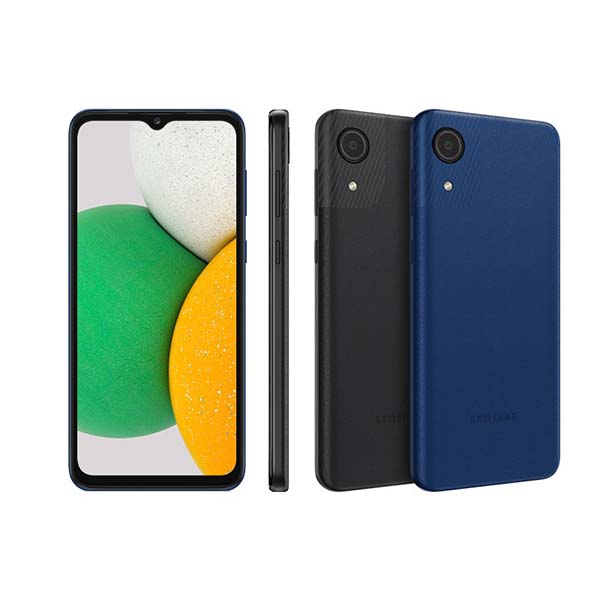
Conclusion
The Samsung Galaxy A03 is a well-rounded budget smartphone that delivers on essential features, making it a good choice for users looking for a reliable device without spending too much. Its long battery life, decent camera, and large display are its standout features, providing excellent value for money in the entry-level segment.
However, its average performance, low-resolution display, and slow charging speed may be limiting factors for users who need more power or faster operation. Overall, the Galaxy A03 is a solid option for those who prioritize affordability and basic functionality over advanced features.
Review
Disclaimer Note
All prices in Pakistan is updated daily from the price list provided by local shops and dealers but we can not guarantee that the information / price on this page is 100% correct (Human error is possible), always visit your local shop for exact cell phone cost & rate.
